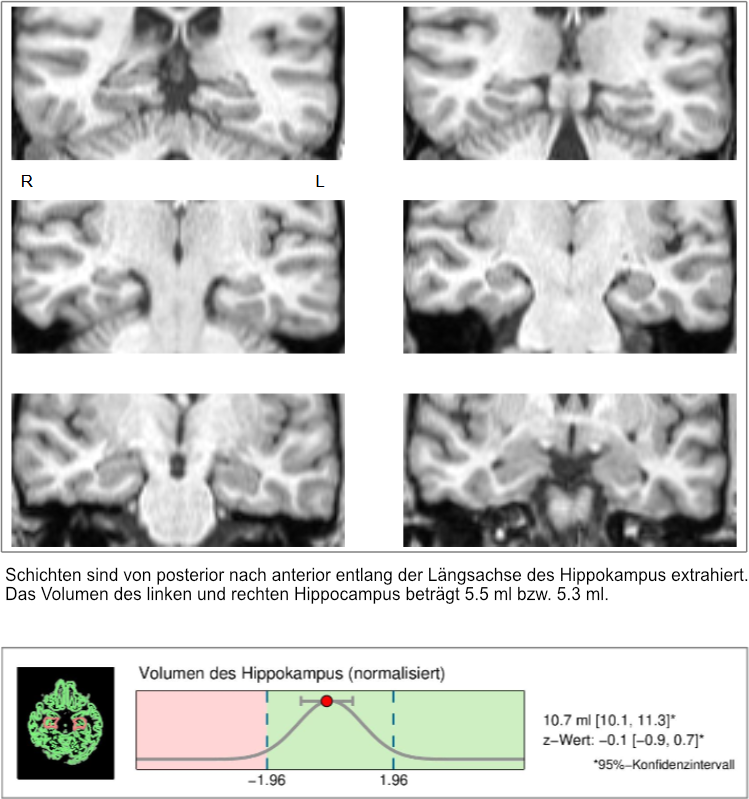Prevention
For prevention jung diagnostics GmbH offers two services, Alzheimer risk diagnostics (ARDX®) and vascular risk diagnostics (VRDX®). These services are not only an extension or supplementation of the portfolio for prevention centres, but can also be used by practising specialists or clinics in the context of their diagnostic work-up.
You want to try out our products?
Alzheimer risk diagnostics (ARDX®)
ARDX® is a standardized, low-threshold test that extends conventional dementia screening tests by an evidence-based biomarker methodology (hippocampal volumetry).
Based on structural magnetic resonance imaging (MRI) data of the head, the individual hippocampal volume is determined with the help of a computer-assisted procedure. The MRI examination takes only a few minutes and is performed without the administration of contrast medium.
.The hippocampal volumetry has been validated in many scientific studies, and the computer-assisted procedure is certified as a medical device.
Indication
Subjects with subjective or mild cognitive impairment who have general risk factors for Alzheimer's disease.
The following are general risk factors:
- older age
- family predisposition
- diabetes
- elevated blood pressure
- Depression

Result of diagnostic test
If the findings are inconspicuous (normal hippocampal volume), incipient Alzheimer's dementia can be ruled out with a high degree of probability at present (Suppa et al. 2015a) and for the next three years (Suppa et al. 2015b).
In the event of an abnormal finding (reduced hippocampal volume), a supplementary diagnostic assessment should be considered.
Suppa P, Anker U, Spies L, Bopp I, Rüegger-Frey B, Klaghofer R, Gocke C, Hampel H, Beck S and Buchert R (2015a) Fully automated atlas-based hippocampal volumetry for detection of Alzheimer's disease in a memory clinic setting. J Alzheimer's Dis 44:183-193. PubMed
Suppa P, Hampel H, Spies L, Fiebach J, Dubois B and Buchert R (2015b) Fully automated atlas-based hippocampal volumetry for clinical routine: validation in subjects with mild cognitive impairment from the ADNI cohort. J Alzheimer's Dis 46:199-209. PubMed
Bartzsch O, Gertheiss J, Calabrese P (2015) value and acceptance of an Alzheimer risk diagnosis. Nervenarzt 86:1549-1554. PubMed
Vascular risk diagnostics (VRDX®)
With increasing age the brain substance slowly decreases. The brain ages like the entire human being. Nowadays, brain structural changes can be detected gently and non-invasively with the help of modern magnetic resonance imaging (MRI) devices.
A loss of brain volume (brain atrophy) in excess of the usual level for normal ageing can be a harbinger of vascular disease of the brain or heart.
For whom is VRDX® suitable?
People with general risk factors for vascular disease, such as high blood pressure, diabetes, overweight, a lipometabolic disorder or smoking, who benefit most from lifestyle changes or treatment of the risk factors before irreparable damage occurs.

Friedman et al. (2014) Brain imaging changes associated with risk factors for cardiovascular and cerebrovascular disease in asymptomatic patients. J Am Coll Cardiol Img 7:1039-1053 PubMed
Enzinger et al. (2005) Risk factors for progression of brain atrophy in aging: six-year follow-up of normal subjects. Neurology 64:1704-1711. PubMed
Debette et al. (2011) Midlife vascular risk factor exposure accelerates structural brain aging and cognitive decline. Neurology 77:461-468. PubMed
Van Elderen et al. (2016) Brain Volume as an Integrated Marker for the Risk of Death in a Community-Based Sample: Age Gene/Environment susceptibility—Reykjavik Study. J Gerontol A Biol Sci Med Sci 71:131-137. PubMed
De Stefano et al. (2016) Establishing pathological cut-offs of brain atrophy rates in multiple sclerosis. J Neurol Neurosurg Psychiatry 87:93-9. PubMed
Paul et al. (2008) Association of alcohol consumption with brain volume in the Framingham Study. Arch Neurol 65:1363-1367 PubMed

